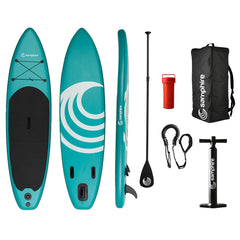
SUP Leashes - Which is right for you?
If you're new to SUP it can be overwhelming choosing your first board. This quick guide is here to help you with the basics of the most essential part of your paddle boarding gear, your leash. You can also check out our guide on how to choose your first board, giving you all the information you need to make an informed decision, making that first SUP ride on your own board the best it can be.
Leash Types
There are coiled or straight leashes available on the market and choosing between the two comes down to personal preference as well as the environment you’ll be paddling in.
Straight leashes are widely used for paddling out in the surf. This is because if the rider gets caught up in a wave the extended length of the straight leash means they’re less likely to be pulled too close to their board and can avoid getting hit by it during a wipeout. Very similar to surfboards where the straight leash is the default. Many surfers that try paddle boarding will lean towards the straight leash as it’s what they’re most familiar with. Other than this environmental advantage there are few advantages that the straight leash holds over the coiled for SUP.

Coiled leashes are designed that way to eliminate the excess slack associated with a straight leash. When attached to the rider they sit neatly on the board out of the water, allowing the paddler to move more freely on smooth or flowing water, avoiding snagging on small logs or objects in the water. It also reduces any drag as it sits on the board. Coiled leashes are great for beginner and experienced paddlers alike.

Attachment Options
Where you attach the leash also depends on the environment and water you’ll be paddling on.
An ankle attachment is good for flat water, but also for surf, due to the same reasons a straight leash is preferred in this environment. The risk of the board being too close to the rider in a wipeout is reduced on a straight leash attached to the ankle as it gives the rider plenty of slack to keep out the way of the board in the event of a fall. The ankle attachment is simple and great for all types of flat water paddling, ideal for beginners and novice riders.
A calf attachment helps prevent the leash from dragging in the water, so is often favoured by racers. It also has the benefit of preventing the rider from becoming tangled in the leash when stepping back for a buoy turn. The calf attachment in general benefits more experienced riders.
Finally the waist attachment. A rider would use this attachment so they can more easily reach the quick release mechanism in case of an emergency. Used in whitewater river SUP, where the rider might need to quickly release themselves from the board if they get caught up in any obstacles. The coil leash is attached to the riders PFD (personal flotation device) and simply means they can reach it quickly. Again an attachment used in specific situations usually for more experienced riders.
If you’re just starting out, the most important thing is to wear a leash for safety. A straight or coiled leash attached to the ankle is a simple and easy way to get out on your board safely.
Need help choosing your first board? Check out our blog post to easily decide on the perfect SUP for your needs.




